
| Miles |  |
monophonic digital lo-fi tablehooter with sample rhythm & many demos |
This tablehooter from 2003 (keyboard PCB date label) appears to be the direct successor of the absurd Golden Camel 7A - one of the certainly worst keyboards of the world. Although it has a very similar case, this one doesn't contain the archaic monophonic tooting Yogmei transistor tone generator with sheet metal contacts anymore. Instead it has now 8 monophonic digital preset sounds, 2 note polyphonic demos and the drumpads play now 7 real sampled percussion noises and some rhythm patterns.
In spite of these modernization, the Golden Camel 11AB is still one of the worst tablehooters ever, since (in unmodified state) especially the rhythm of this yelling shanzhai beast distorts horribly, and there are only 2 volume settings (ear tormenting loud - and louder!). In spite of this the rough digital sounds can be nice for tekkno. (Unfortunately the rhythm CPU of my specimen is faulty and makes mess after half a minute.)
The 7 leftmost keys are fake and do the same like the 4 drumpads.  Although
the case bottom this instrument has a proud "Miles® - quality
certificate" sticker, the hardware of this bad hoax is no quality product
at all, but looks like soldered together as piecework in a Chinese concentration
camp; like the Golden Camel 7A it is an incredible mess of loose
cables, and even the main CPU (a tiny COB module) rumbles loosely around
and hangs only on thin wires - ready to make a short circuit with everything
that comes in its way. Also the control panel still uses metal contacts
of questionable reliability, and the button panel is still fake since all
alphabet letter buttons {"A".."L"} on each half are internally connected
and do the same. And worst - the yellow "DC 9V" AC adapter jack is still
wired parallel(!) to the battery compartment, thus any attempts to use
it with batteries inserted, may cause the batteries to EXPLODE (and also
the microphone would certainly not survive to be accidentally plugged in
here instead of the identical "karaoke" jack below it).
Although
the case bottom this instrument has a proud "Miles® - quality
certificate" sticker, the hardware of this bad hoax is no quality product
at all, but looks like soldered together as piecework in a Chinese concentration
camp; like the Golden Camel 7A it is an incredible mess of loose
cables, and even the main CPU (a tiny COB module) rumbles loosely around
and hangs only on thin wires - ready to make a short circuit with everything
that comes in its way. Also the control panel still uses metal contacts
of questionable reliability, and the button panel is still fake since all
alphabet letter buttons {"A".."L"} on each half are internally connected
and do the same. And worst - the yellow "DC 9V" AC adapter jack is still
wired parallel(!) to the battery compartment, thus any attempts to use
it with batteries inserted, may cause the batteries to EXPLODE (and also
the microphone would certainly not survive to be accidentally plugged in
here instead of the identical "karaoke" jack below it).
 |
 |
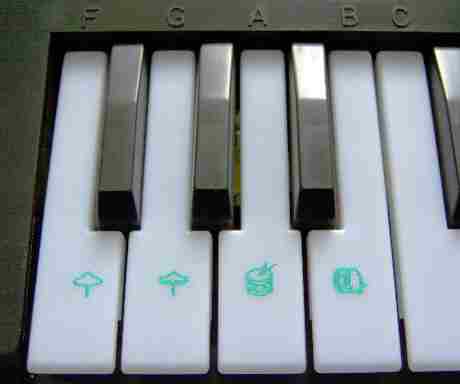 |
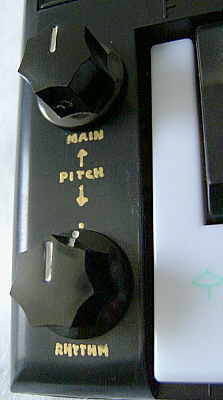 |
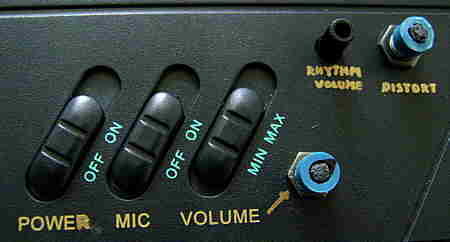 |
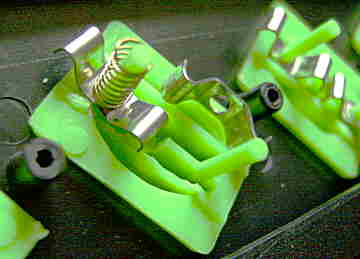 |
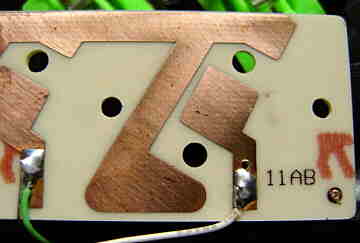 |
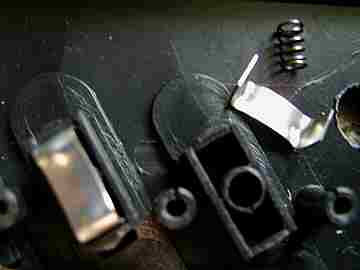 |
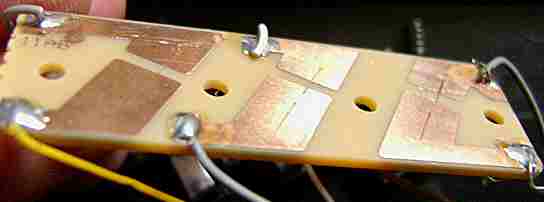 |
| All Buttons and switches scrape with metal on bare copper traces. | |||
The main voice preset sounds are made from each a static digital waveform with simple volume envelope. The timbres have audible beeping components due to the very low waveform sample resolution, but otherwise they resemble more or less typical filtered multipulse squarewave. They all sound thin and fairly harsh, which likely has also to do with the bad speaker and amplifier. Due to there are no preset sounds listed, all sound names were chosen by me. The "guitar" sounds a bit harsh and its decay phase ends too soon. The "trumpet" plays much quieter than the other presets and has a thin and harsh timbre that resembles bagpipes. The "pipe organ" is the typical multipulse squarewave timbre that attempts to sound like a metal pipe organ rank. The "e-piano" has a clarinet timbre, but starts to fade silent after a second with held notes, and has a little sustain. During decay the timbre turns a bit brighter (like a mild wahwah effect). The "e-bass" has a bit hollow timbre that in the mid range reminds to a banjo and also fades brighter during decay, but the envelope sounds too linear. The "banjo" has a harsh timbre (like intended?) and a shorter decay envelope. The "saxophone" is too harsh in the mid range and a delayed decay phase prevents to play very short notes. The "mandolin" rings with about 8 Hz. Unfortunately the keyboard matrix sometimes skips notes during very fast play, and pressing more than 1 key plays a wrong note pitch (depending on the key combination). A bit bizarre is also that when a key is held down and a lower note is played, the instrument switches to the pitch of the lower note and doesn't end the note before both keys are released. Unlike the Golden Camel 7A, there is no vibrato effect (although claimed on the box).
The percussion is made from grainy low- res samples those sound quite distorted (with unmodified amp mine was extremely harsh and hissy); especially the bongos clip noticeable. The scratch noise sounds like a zip. Both the "snare" and "base" timbre resemble a timpani and could certainly sound quite fat and bassy when the transistorized amp is modified a bit more.
The rhythm is produced by a digitally totally independent separate CPU, and thus can be also started and stopped during demos etc. without interfering with the main CPU in any way. Unfortunately my first rhythm CPU badly suffered of chip cancer; it played semi- random "jungle" rhythms after about half a minute (depending on its temperature) because its internal sequencer freaked out. Thus I later transplanted the intact rhythm CPU from another specimen of this keyboard (which apparently has a bad amplifier because it plays too quiet and distorts badly). With rhythm off, the drumpads play each a percussion sample. Although there are only 4 drumpads, 3 additional percussion can be played by pressing multiple pads together (e.g.. cl. cymbal + open cymbal = low bongo, cl. cymbal + open cymbal + base = high bongo, snare + base = scratch). Also the leftmost 7 keys are wired parallel and thus do the same like the 4 drumpads. With the 5th (rightmost) drumpad button rhythm can be switched on and off. When on, it plays a monophonic preset rhythm pattern (there is only one) of fixed speed, and the drumpads now play each a different fill-in (7 in total) instead of the 7 percussion sounds. Each fill-in pattern plays 2 times before it switches back to the normal rhythm pattern. There is no tempo control. When a drumpad sound was played before switching rhythm on, the rhythm starts with its corresponding fill-in before the normal rhythm patterns begins. But with my faulty rhythm CPU the pattern made more and more mess and turned into semi- random jungle grooves and drumrolls when the instrument warmed up, and also the fill-ins turned into shorter and semi- random patterns. I first though it were no bug but a feature based on a random number generator, but it turned out that the patterns stay longer stable when I reduced its supply voltage (normally 3.4V, I added a trimmer for this), but at too low voltage (2V and lower) the rhythm distorted and also stopped in the middle of a pattern when cold. (The rhythm CPU is only powered through a voltage divider of a few 100 Ohms and thus anyway didn't turn feelable warm even after long operation.) With rhythm off, my rhythm CPU also started to play quiet click/ pop noises every 2 seconds when drumpads are played with rhythm off. The clicking stops after starting and stopping rhythm again.
The 22 demo musics are:
| removal of these screws voids warranty... | ||
 |
||
|
|